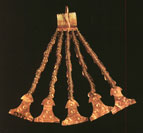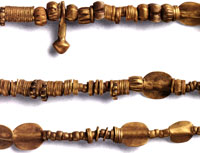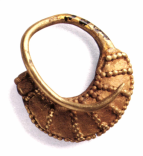| L.I. Avilova
Trojan gold
…if hereafter the gods vouchsafe him to sack the city of Priam,
you can come when we Achaeans are dividing the spoil,
and load your ship with gold and bronze to your liking.
Homer. The Iliad. Translation by Samuel Butler.

The position occupied by Troy in the context of ancient history of Anatolia and South-Eastern
Europe needs no explanations. Heinrich Schliemann was the first to investigate this site
archaeologically over 130 years ago, since 1870 (Schliemann, 1881), and it has been one of the most
important monuments in Western Asia and the Balkans ever since, despite Schliemann s erroneous
ideas on the chronology of the antiquities he had discovered. The epoch of the Trojan War berhymed
in Homer s Iliad corresponds to stratum VII of the site and dates to the Early Iron Age, whilst
the most impressive cultural deposits were formed in the Bronze Age, this period comprising five
lower strata of the ancient city (Blegen et al., 1950; 1951; 1953). Chronological sequence of Troy
represents the ground for dating numerous archaeological cultures and sites, both adjacent and
distant ones; it is permanently adjusted and improved using traditional and modern methods,
including radiocarbon dating (Korfmann, Kromer, 1993).
Of special interest is the theme of Trojan metal finds, among them those made of precious metals
originating from numerous hoards, or treasures, that also were erroneously dated back to the epoch
of Homer by Schliemann. Recently the problems related to the Trojan collections has become the
subject of wide discussion in Russia, in particular, the interest was induced by the exhibition
shown in 1996 in the Pushkin Museum of Fine Arts in Moscow and the conference Troy and her
treasures held in the same year (Сокровища Трои из раскопок Генриха Шлимана, 1996).
 I have participated in the long-term project of the Laboratory of natural sciences, the Institute
of Archaeology, Russian Academy of Sciences, concerning the problems of the Circumpontic
metallurgical province, and it was quite logical that my attention turned to the metal finds from
Troy. During last 15 years my activity was aimed at compiling and extending computer database (DB)
for ancient metal artefacts, detailed information on those from Troy being recorded. The results
were published (Авилова, Черных, 1989; Černyh et al., 1991), but the Trojan material was
included into the general DB for Asia Minor and was not presented as the subject of special
publication. The present work seems of some interest to improve this situation, the more so that
the detailed catalogue of the mentioned exhibition contains also the data on the collections from
Troy preserved in the museums of Philadelphia and Athens. This has permitted to verify quantitative
and morphological characteristics of the Trojan DB published in the present paper, which also
suggests the comprehensive evaluation (to the extent now possible) of the collection of non-ferrous
and precious metals from Troy considered the against background of culturally related sites of
Anatolia.
 I should briefly dwell upon the computer DB structure. All the materials are divided into classes
in accordance with their function, and classes comprise sets of categories. Class 1 includes tools
and weapons, such as shaft-hole axes, flat axes, chisels, spearheads, knives/daggers, awls,
sickles, and so forth. Class 2: personal ornaments and costume details (beads, pins, pendants,
earrings, buckles, and the like). Class 3: protective armour (helmets, plait armour details). Class
4: horse harness (cheek-pieces, rein-rings). Class 5: metal vessels. Class 6: objects of religious
purpose and markers of high social status (figurines, seals, musical instruments details, wands,
and so forth). Class 7: non-finished goods (ingots, blanks). Class 8: negatives on casting moulds,
both stone and clay ones. Class 0: artefacts of unclear function, fragments.
Principally, one artefact corresponds to one DB record containing its characteristic.
Nevertheless, sometimes it was impossible to keep this principle, since there are a number of
objects that cannot be counted absolutely accurately. Mostly these are small personal ornaments
seriously damaged (oxidised or burnt), like necklaces of many tiny beads, or sets of earrings. Such
cases are not numerous, nevertheless they were taken into account, and the way out was to evaluate
the number of objects approximately at least to shape an idea of whether there were tens or
hundreds of the finds of this kind. In fact, the above approach contains an element of uncertainty,
but it cannot play any decisive role for the vast collection in question, so the basic figures seem
to be quite reliable.
Each DB record includes around 50 fields that describe the artefact proper (category, type, shape,
construction); cultural and chronological attribution of the find (archaeological association,
stratigraphic and cultural context, relative chronology); references to the site, excavations,
publications; material used (metal, or alloy formula if the artefact was spectrally analysed and 10
chemical elements content established). The DB was processed using special statistical programs
worked out in the Laboratory of natural sciences, the Institute of Archaeology. The results are
shown in the published tables.
 The presented material was distributed according to two basic chronological the Early and the
Middle Bronze Ages. The EBA corresponds to level I of Troy, and the MBA to layers II-V. The periods
of the Late Bronze Age (Troy VI) and the Early Iron Age (Troy VII) are not considered in this work.
The database includes 32381 finds from Troy, all the artefacts but 4 stone shaft-hole axes
attested to treasure L were made of copper and copper-based alloys, silver, gold, and lead.
Striking disparity of the total amount of finds as considered within the chronological periods is
observed: only 10 of them are dated to the EBA, and 32371 to the MBA. The contrast is even more
staggering if the metals represented in the both collections is taken into account. The EBA
artefacts are made of copper/bronze, one lead item being registered, while the MBA collection
comprises mass finds manufactured of precious metals (gold and silver), the former making the
overwhelming majority of practically 99% (Table 1).
Table 1
Troy. Chronological distribution of finds.
| Material |
EBA |
MBA |
%% |
| Copper/bronze |
9 |
320 |
1 |
| Gold |
|
31945 |
98,7 |
| Silver |
|
101 |
0,3 |
| Lead |
1 |
1 |
|
| Stone |
|
4 |
|
| Total |
10 |
32371 |
100 |
 Considerable difference is also observed in representativeness of the functional classes of finds,
class 1 of tools/weapons and class 2 of personal ornaments being the basic statistical indicators.
Again the picture of sharp contrast in their distribution arises: in the EBA selection, though
strongly limited, only the mentioned classes are present in equal parts, whilst in the next period
the repertoire of functionally different classes is far more extensive. Besides tools/weapons and
personal ornaments there appear metal vessels, objects of religious purpose and social markers, as
well as half-finished items (the silver ingots of standard shape and weight, golden wire with
regularly cut up marks on it to produce small ornaments). These observations evidence not only
sharp quantitative growth of production, but also impressive diversity of the repertoire of metal
artefacts (Table 2).
Table 2
Troy. Chronological distribution of functional classes of finds.
| Functional classes of finds |
EBA |
MBA |
%% |
| 1 - tools/weapons |
5 |
121 |
0,4 |
| 2 - ornaments |
5 |
32126 |
99,2 |
| 5 - vessels |
|
19 |
|
| 6 - finds of religious purpose |
|
93 |
0,3 |
| 7 - half-finished items |
|
12 |
|
| Total |
|
32371 |
100 |
Personal ornaments are enormously abundant, they dominate over the remainder making over 99% of
the selection. A question may arise, whether it is correct to interpret all the multiple minor
finds, such as beads, pendants making up necklaces and diadems, and so forth to be registered as a
separate artefact each. I consider them to be such, since each tiny bead was produced individually:
cast or forged, then processed by a professional craftsman with certain labour expenditure. The
value of the raw material also should be taken into account. Gold and silver were highly valued in
prehistoric times, price ratio of gold to copper in ancient Babylonia was approximately 1 to 1000,
and that of silver to copper was determined around 1 to 180 (Янковская, 1986). That is why beads
and pendants were counted accurate to one, to the extent possible.
The cultural deposits dated back to the discussed epoch of the MBA had yielded a number of
individual finds and 14 associations of artefacts traditionally termed as treasures (on the
reliability of this attribution see below). I should give a brief account for the composition of
the complexes.
 Treasure A (Priam s treasure). 27259 finds (27210 Au, 7 Ag, 42 bronze). 10 knives, 15 flat axes, 3
chisels, 8 spearheads, 1 saw of bronze; 13 vessels (5 bronze, 4 Au, 4 Ag); 8130 Au beads; 16 Au
pendants; 44 Au conical plates; great Au diadem (includes 16441 details: 12271 rings, 4066
scale-plates, 90 chains, 14 pendant idols); minor Au diadem (includes 2211 details: 1750 rings, 354
scale-plates, 64 chains, 1 ribbon, 42 pendant idols); 2 Au basket-shaped earrings (totally include
158 details: 11 chains, 118 scale-plates, 18 tubes, 11 pendant idols); 2 Au basket-shaped earrings
(totally include 145 details: 11 chains, 107 scale-plates, 16 tubes, 11 pendant idols); 51 Au
lunate earrings; 3 Au bracelets; 3 Au torques (bracelets?); 4 Au tacks; 3 Ag ingots.
Treasure В. 3 finds. 3 vessels (1 bronze, 2 Ag).
Treasure С. 1 find. 1 bronze flat axe.
Treasure D. 832 finds of Au. 1 pin, 5 lunate earrings, 2 granulated earrings, 1quadruple spiral
bead, 373 big hollow beads, ~450 loop-like pendants.
Treasure F. 12 finds of Au. 1 bracelet, 1 pin, 2 basket-shaped earrings, 2 ring-shaped earrings, 1
bar-ingot with openings, 5 bar-ingots cut up with marks.
Treasure H a. 62 finds of Au. 9 pendant idols, 5 chains, 48 scale-plates.
Treasure J. 171 finds. 169 finds of Au. 5 lunate pendants, 5 lunate earrings, 1 basket-shaped
earring, 5 chains, 85 scale-plates, 5 pendant idols, 1quadruple spiral bead, 61 rings, 1 bracelet
(torque?). 2 shapeless ornaments of Ag.
Treasure К. 5 bronze finds. 3 flat axes, 1 anthropomorphic figurine, 1 open-work ornament of
uncertain function.
Treasure L. 104 finds. 4 ceremonial shaft-hole axes of stone, ~50 Au ornaments (conglomerate of
small-size artefacts), ~50 Ag ornaments (conglomerate of small-size artefacts).
Treasure N. 39 finds. 37 finds of Ag. 1 bracelet, 2 torques, 1 ring-shaped earring, 12 earrings in
conglomerate, 20 small beads in conglomerate. 2 finds of Au 1 lunate earring, 1 crescentic
earring.
Treasure О. 2 finds of Au. 1 pin surmounted with tiny vessels, 1 bispiral pin decorated with
rosette.
Treasure R. 8 finds. 6 finds of Au. 1 pin, 1lunate earring, 1 quadruple spiral bead, 3 spirally
coiled wires. 2 bronze pins.
Treasure in room 206. 151 Au beads.
Treasure in room 252. 1284 finds of Au. 2 pins, 1 ring-shaped earring, the remainder beads.
Two more treasures originate from layer VI attested to the period of the Late Bronze Age
and are not considered in the paper. These are treasure Н b (large golden plate decorated with
rosette), and treasure P (5 bronze artefacts 1 double-axe, 1 flat axe, 3 sickles).
The most of the associations in question were discovered in the course of Schliemann s
excavations, their archaeological context is not quite clear, which is logical having in mind the
level of field investigations of the epoch. Controversial information given by Schliemann in his
field records and publications had resulted in accusation him of forgery; he was suspected of
having put together the artefacts found in many findspots at Troy (or even purchased from the art
dealers) to form a sensational artificial association with the aim to cause a big stir in the
scientific circles. This concerned at least the most startling treasure A (called by Schliemann
Priam s treasure). The debates have lasted till recently (Traill, 1983). However, the position of
those who do not back up these accusations (Easton, 1984) seems to be more grounded, the more so
that the posterior excavations have also recovered treasures comprising precious ornaments in rooms
206 and 252 of layer II g (Blegen et al., 1950). Two reliable treasures of precious artefacts were
discovered in the settlement Eskiyapar in Central Anatolia dated from the same period of Troy
II-III (Özgüc, Temizer, 1993).
The identification of the rich associations from Schliemann s excavations as treasures proper
raises much more doubts, most probably, the scholar had not realised that they were rather the
burials of elite, a royal cemetery similar to those investigated at Alacahöyük
(Koşay, 1951) and Horoztepe (Özgüc, 1965). In fact, the Bronze Age necropolis did
exist at the site of Troy: the burial in stone cist, though not furnished with grave goods was
accounted for by K. Blegen s excavations (Blegen et al., 1950. P.255).
Let me suggest a brief survey of the Anatolian sites comparable with Troy of the MBA epoch.
Eskiyapar treasures A and B. 1765 finds, 1531 Au, 234 Ag. They represent personal ornaments
(99,5%), 7 vessels, and ceremonial electrum shaft-hole axe.
Alacahöyük royal tombs. I have succeeded in reliable recording 853 finds (330 ones of
bronze, 1 of iron, 491 Au, 31 Ag). They comprise personal ornaments (74%), the items of religious
function and markers of high social status (13,6%), tools/weapons, and vessels.
Horoztepe (the remains of pillaged royal cemetery). 110 finds were recorded (96 ones of bronze, 6
Au, 8 Ag). Their repertoire is not quite the same as that displayed by Trojan complexes, the
picture has been distorted due to the finds' provenance from the illegal diggings. Personal
ornaments' share is very small (7%), the items of religious purpose prevail (38%), classes of
tools/weapons and vessels are also numerous (33% and 21% respectively).
The above comparisons permit to state that the amazingly rich associations from Schliemann s
excavations in Troy did not constituted absolutely isolated phenomena in the Middle Bronze Age
Anatolia. To show this I point out some statistical characteristics of the Trojan collection of
metal artefacts against the background of Anatolia as a whole. Of 22 processed sites with the EBA
deposits the collection of 373 finds originate, including trifling number of 10 items from Troy I,
which makes 2,7% of the total. As for the MBA collection, cardinal shift is observed: 54 sites with
the corresponding deposits have produced 36586 finds, and 32371 or 88,5% of them were found in
Troy. The rest of 4215 originate from 53 other sites (Table 3).
Table 3
Distribution of the MBA finds according to the material used.
| Material | Anatolia as a whole | Troy | %% |
| Copper/bronze | 2125 | 320 | 15 |
| Gold | 33997 | 31945 | 94 |
| Silver | 396 | 101 | 29 |
| Lead | 33 | 1 | |
| Iron | 1 | | |
| Stone/clay | 34 | 4 | |
Thus we can clearly see that in the EBA Troy was an ordinary, moreover, a very modest settlement,
and Anatolia was far from being abundant in any metal artefacts, it was surpassed by Mesopotamia
and the Levant (the corresponding databases include 580 and 700 finds respectively). But the MBA
epoch in Anatolia is marked by considerable progress in metal producing and metalworking; the
region had shot ahead and occupied practically the same positions as Mesopotamia, its social
development having reached the stage of early state. The MBA Anatolia displays all the indications
typical of this pattern of civilisation: urban settlements, architecture of palace type, temple
structures, cemeteries of social elite. The impressive collections of metal artefacts, including
treasures of gold and silver finds should be viewed as the evidences of this breakthrough. The
present work is also aimed at making more clear the position occupied in the early society by
jeweller s craft: it was its production that served for visible personification and vivid
manifestation of the basic ideas of advanced social position, power, and related material wealth,
and their ideological substantiation.
Bibliography:
Авилова Л.И., Черных Е.Н., 1989. Малая Азия в системе металлургических провинций // Естественнонаучные методы в археологии. М.
Сокровища Трои из раскопок Генриха Шлимана. ГМИИ им. А.С.Пушкина - Леонардо Арте. М., 1996.
Янковская Н.Б., 1986. К проблеме оптовой торговли Каниша // ВДИ. № 2.
Blegen C.W., Caskey J.L., Rawson M., Sperling J. 1950. Troy. Vol. I. The first and second settlements. Princeton.
Blegen C.W., Caskey J.L., Rawson M., 1951. Troy. Vol. II. The third, fourth and fifth settlements. Princeton.
Blegen C.W., Caskey J.L., Rawson M., 1953. Troy. Vol. III. The sixth settlement. Princeton.
Cernyh E.N., Avilova L.I., Barceva T.B., Orlovskaja L.B., Tenejsvili T.O., 1991. The Circumpontic metallurgical province as a system // East and West. Vol. 41.
Easton D.F., 1984. "Priam's treasure" // Anatolian Studies. V. 34.
Korfmann M., Kromer B. Demircihoyuk, Besiktepe, Troia - eine Zwischenbilanz zur Chronologie dreier Orte in Westanatolien // Studia Troica. Bd. 3. Mainz am Rhein.
Koşay H.Z., 1951. Alaca Höyük kazisi 1937-1939. Les fouilles d Alaca
Höyük. Ankara.
Özgüc Т., 1965. New finds from Horoztepe // Anatolia. V. 8.
Özgüc T., Temizer R., 1993. The Eskiyapar treasure // Aspects of art and iconography: Anatolia and its neighbours. Studies in honour of Nimet Özgüc. Ankara.
Schliemann H., 1881. Ilios: The city and country of the Trojans. London.
Traill D.A., 1983. Schliemann's "discovery" of "Priam's treasure" // Antiquity. V. 57.
|
